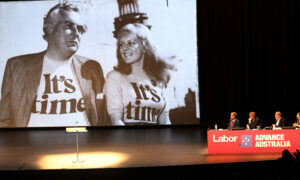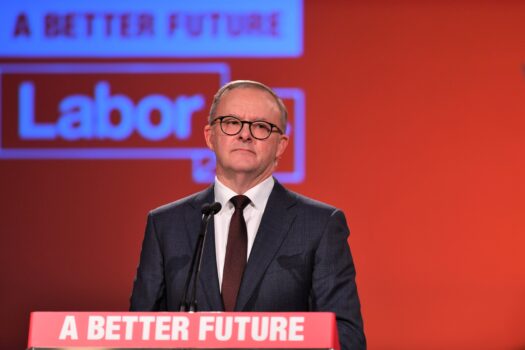Will Albanese Walk in the Footsteps of Whitlam?
Commentary The year 2022 was the Golden Jubilee of the election of Gough Whitlam’s government, as well as the inaugural year of Anthony Albanese’s. Whitlam faced similar economic challenges to Albanese and had some strikingly similar solutions, leading some to expect Albanese will emulate him and crash and burn within three years. I’m not so sure. Whitlam is a touchstone in Australian politics. He is revered by the Labor faithful as the man who modernised the country and the party and loathed by conservatives and the middle-ground as the man who almost broke the bank. Elected in 1972 on the slogan “It’s time,” backed by an advertising jingle and countless celebrities, he gained a slim majority of seven, faced a double-dissolution election within 18 months, and was subsequently ejected from office with a record loss in 1975 after having been sacked by the governor-general. Along the way, he expanded the size of the Commonwealth government by around a third to 23.5 percent of GDP, abolished university fees, established Medibank (now called Medicare), re-established relationships with China (while cutting them with Taiwan), cut tariffs by 25 percent, revalued the dollar, and established an Aboriginal Land Fund. His biggest challenges were economic—the OPEC Oil Shock, persistently high inflation, and a recession; and personnel—a series of scandals caused by incompetent ministers. Whitlam effected social change in the Labor Party, particularly its branches, transferring control from its founding blue-collar base to a university-educated white-collar one, and he reversed the status quo of 23 years of Liberal-National coalition. After he lost, Whitlam became the template for future Commonwealth Labor governments of “what not to do,” with the Hawke/Keating government strenuously disavowing any intellectual links. Yet Whitlam has always held the heart of the Labor movement. Parallels 50 Years Apart They say history doesn’t repeat, but it does rhyme. There are certainly many similarities between the economic challenges faced by both Whitlam and Albanese. Fossil fuel prices are, in some cases, such as thermal coal and natural gas, at record highs, and in the case of oil, at a price substantially above the average of the last 10 years. Additionally, the government’s net-zero policy by 2050 is set to dramatically increase power prices as cheap-at-the-margin-and-expensive-in-the-network unreliables, like wind and solar, are added to the system. At the same time, the previous Morrison government substantially boosted the size of government with spending increasing from 27.7 percent of GDP in 2020 to 34.8 percent in 2021, and money supply over the course of the pandemic rose between 30 and 50 percent. Albanese will find government spending hard to rein in, just as it was for Whitlam, even though most of the increases are the work of others. Leader of the Opposition Anthony Albanese delivers a speech to Labor supporters at the Wests Ashfield Leagues Club in Sydney, Australia, on Dec. 5, 2021. (AAP Image/Dean Lewins) He has inherited the National Disability Insurance Scheme (NDIS), originally from the Gillard government, which is set to overtake Medicare expenditure by 2025. That’s assuming Medicare expenditure doesn’t increase, which it probably will as the government is under pressure to bolster bulk-billing. Labor has also made promises to increase the number and payment of nurses in aged care and increase the subsidies and eligibility for childcare, both of which will hit budget expenditure. They have also made promises for massive capital expenditure in energy and housing, which will freeze out more productive private investment in other areas of demand and stretch government borrowing. Wages are also on an upward trajectory. The Australian Council of Trade Unions has made the bizarre claim that company profits cause inflation, and the only way to beat it is to increase wages. With a new government, the Fair Work Commission seems to agree. Legislation introduced in the last sitting of parliament now makes pattern bargaining legal again (first time since 2005), and the government has also signalled it will try to eliminate “insecure” work, which looks like a direct attack on contractors and the gig economy. This has the potential to lead to wage rises on the back of decreased flexibility and decreased productivity. A store worker prepares grapes for sale at Paddy’s Market in Sydney, Australia, on Oct. 22, 2022. (Lisa Maree Williams/Getty Images) So all the conditions for stagflation—rapidly increasing government expenditure, skyrocketing energy prices, an inflexible economy, and low productivity growth—are in place as they were for Whitlam, coupled with similarly ambitious social policies. There is even an echo of Whitlam in The Voice referendum. The Voice owes its provenance to his Aboriginal Land Fund, immortalised in the picture of him sitting down at Wave Hill Station and pouring sand from

Commentary
The year 2022 was the Golden Jubilee of the election of Gough Whitlam’s government, as well as the inaugural year of Anthony Albanese’s. Whitlam faced similar economic challenges to Albanese and had some strikingly similar solutions, leading some to expect Albanese will emulate him and crash and burn within three years.
I’m not so sure.
Whitlam is a touchstone in Australian politics. He is revered by the Labor faithful as the man who modernised the country and the party and loathed by conservatives and the middle-ground as the man who almost broke the bank.
Elected in 1972 on the slogan “It’s time,” backed by an advertising jingle and countless celebrities, he gained a slim majority of seven, faced a double-dissolution election within 18 months, and was subsequently ejected from office with a record loss in 1975 after having been sacked by the governor-general.
Along the way, he expanded the size of the Commonwealth government by around a third to 23.5 percent of GDP, abolished university fees, established Medibank (now called Medicare), re-established relationships with China (while cutting them with Taiwan), cut tariffs by 25 percent, revalued the dollar, and established an Aboriginal Land Fund.
His biggest challenges were economic—the OPEC Oil Shock, persistently high inflation, and a recession; and personnel—a series of scandals caused by incompetent ministers.
Whitlam effected social change in the Labor Party, particularly its branches, transferring control from its founding blue-collar base to a university-educated white-collar one, and he reversed the status quo of 23 years of Liberal-National coalition.
After he lost, Whitlam became the template for future Commonwealth Labor governments of “what not to do,” with the Hawke/Keating government strenuously disavowing any intellectual links.
Yet Whitlam has always held the heart of the Labor movement.
Parallels 50 Years Apart
They say history doesn’t repeat, but it does rhyme.
There are certainly many similarities between the economic challenges faced by both Whitlam and Albanese.
Fossil fuel prices are, in some cases, such as thermal coal and natural gas, at record highs, and in the case of oil, at a price substantially above the average of the last 10 years. Additionally, the government’s net-zero policy by 2050 is set to dramatically increase power prices as cheap-at-the-margin-and-expensive-in-the-network unreliables, like wind and solar, are added to the system.
At the same time, the previous Morrison government substantially boosted the size of government with spending increasing from 27.7 percent of GDP in 2020 to 34.8 percent in 2021, and money supply over the course of the pandemic rose between 30 and 50 percent.
Albanese will find government spending hard to rein in, just as it was for Whitlam, even though most of the increases are the work of others.

He has inherited the National Disability Insurance Scheme (NDIS), originally from the Gillard government, which is set to overtake Medicare expenditure by 2025.
That’s assuming Medicare expenditure doesn’t increase, which it probably will as the government is under pressure to bolster bulk-billing.
Labor has also made promises to increase the number and payment of nurses in aged care and increase the subsidies and eligibility for childcare, both of which will hit budget expenditure.
They have also made promises for massive capital expenditure in energy and housing, which will freeze out more productive private investment in other areas of demand and stretch government borrowing.
Wages are also on an upward trajectory. The Australian Council of Trade Unions has made the bizarre claim that company profits cause inflation, and the only way to beat it is to increase wages.
With a new government, the Fair Work Commission seems to agree. Legislation introduced in the last sitting of parliament now makes pattern bargaining legal again (first time since 2005), and the government has also signalled it will try to eliminate “insecure” work, which looks like a direct attack on contractors and the gig economy.
This has the potential to lead to wage rises on the back of decreased flexibility and decreased productivity.

So all the conditions for stagflation—rapidly increasing government expenditure, skyrocketing energy prices, an inflexible economy, and low productivity growth—are in place as they were for Whitlam, coupled with similarly ambitious social policies.
There is even an echo of Whitlam in The Voice referendum. The Voice owes its provenance to his Aboriginal Land Fund, immortalised in the picture of him sitting down at Wave Hill Station and pouring sand from the land, where a 30-year lease had just been purchased for the Aborigines, into the hands of elder Vincent Lingiari.
Where the Paths Diverge
However, some differences suggest Albanese could be more radical than Whitlam, yet more long-lived.
The electorate was ready for a change after 23 years of the Coalition government, but not too much. They found much of Whitlam’s agenda unsettling, and it was said Labor tried to do too much too soon. He was swimming against the tide.
Albanese is much more in tune with contemporary Australia. Surveys show that millennials, for example, trust socialism more than capitalism.
The culture that is pumped out through educational institutions and the media is more radical and left-wing than it ever has been. Added to that is the new social media, also a haven for the mavens of the left.
He also has recent experience in government to draw on. It’s argued Whitlam was shambolic because no one in his cabinet had been in a government before. However, Albanese has a cadre of ministers blooded during the Rudd-Gillard-Rudd years, with 70 percent having served in previous governments.
Whitlam was also handicapped by control of the Senate, being in the hands of his enemies. In the case of Albanese, it is controlled by his frenemies—Greens and independents—who will surely not be as obstructive to his agenda as the Liberal-National parties were to Whitlam.

Or maybe they will, as arguments over the government greenhouse agenda are starting to suggest.
And then there is the quality of the opposition. Fraser was playing with a fairly powerful deck when he beat Whitlam, but the quality of the current opposition has been significantly degraded as a result of the Teals and Greens eating into heartland metropolitan seats.
Another element, lacking in Whitlam’s time, is the potential security threat to Australia. Australia was moving away from its Vietnam engagement in 1972 but now appears to be moving into an engagement with China, Russia, Iran, and North Korea. External threats tend to encourage citizens to rally around the government.
The same is not true for bad economic times, which tend to see governments punished.
The final arbiter of Whitlam’s success was a recession. But, unfortunately, it may also be the executioner of the Albanese government.
It’s always better to win an election than to lose it, but some victories have harder landings than others: 1972 was not a good year to win government, and 2022 was the most challenging in the 50 years since.
Views expressed in this article are the opinions of the author and do not necessarily reflect the views of The Epoch Times.












